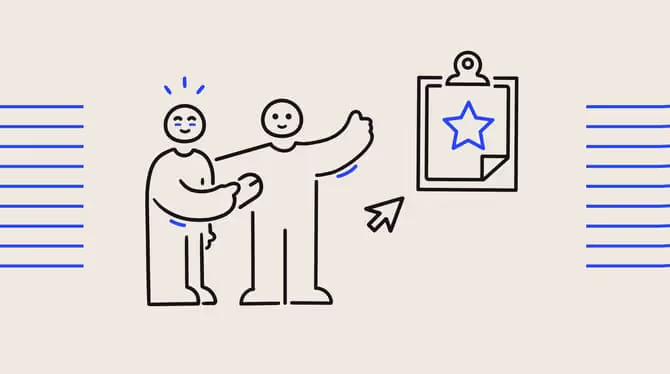10 Performance management plan ideas and how to effectively implement them

Discover Workleap Officevibe's benchmark report on 12 key employee engagement metrics

What do a sports team without a coach and a company without a clear plan have in common? Chaos! That's right — just as a coach rallies athletes or a well-defined strategy leads a business to success, planning is key to the success of any organization.
In this article, we'll dive into the essence of performance management plans. We'll explore their purpose, how to implement them, and provide you with a handful of examples (for high performers and those who need a little boost), to make sure your team is playing the right moves.
What is the purpose of performance management planning?
The purpose of performance management planning is to lay the foundation for a high-achieving workforce. It's not just about conducting annual performance reviews. Performance management planning is a continuous, dynamic process that involves setting clear expectations, providing regular feedback, and creating a roadmap for growth. It aims to ensure that every team member is working in harmony with the organization's objectives and their personal development.
Are performance improvement plans (PIP) the same thing?
A performance improvement plan (PIP) is a specific type of performance plan. It's a structured support system meant to help employees struggling with poor performance. Now, a performance improvement plan isn't a punitive measure — it's a good thing!
PIPs are the bridge between identifying areas for growth and achieving the best possible performance. They provide employees with a tailored map for self-improvement, complete with actionable steps and resources to help them excel. PIPs are a demonstration of your organization's investment in its employees, ensuring they have the tools and guidance they need to become top performers.
Performance management planning is the philosophy while performance improvement plans are tools to help employees. Both performance management planning and PIPs are vital components of building a successful, high-performing team.
Why you shouldn't underestimate having a performance management process
Performance management is all about optimizing your team's potential. By implementing a performance management process, you set the stage for continuous improvement and long-term success. You boost employee morale, enhance productivity, and align your team with company goals.
In short, it's the ultimate playbook for unlocking the full potential of your employees. As an HR leader, it's important to spruce up your knowledge of the performance management process and how it has evolved and will continue to evolve.
Benchmarking performance management — all part of the plan!
On the road to improving performance management, understanding where you currently stand is essential. And measurement is the keystone.
You must establish your organization's current performance baseline to lay the foundation for a successful performance management plan. Benchmarking provides this critical starting point, something every good strategy has. It's akin to knowing your current location on a map before planning your journey. With this point of reference, measuring your progress as you embark on your performance management adventure is easier.
{emphasize}Imagine you're a retail manager aiming to boost your store's sales. To measure your progress effectively, you need to know your current sales figures. If you're currently averaging $10,000 in weekly sales, this is your performance benchmark. To increase this, you need to set realistic and measurable goals.{emphasize}
Remember: Establishing performance standards and goals is fundamental
Expectations and performance goals are the bedrock of an effective performance management plan. When you have a team in which every member is crystal clear about their expectations and the specific goals they need to achieve, you create a collective confidence that's incredibly powerful. This shared understanding ensures everyone is working toward meeting the same organizational goals.{emphasize}
{emphasize}Say you're leading a marketing team. You've set clear expectations for your content creators to publish four high-quality blog posts each month. Additionally, you've established a goal for the team to increase website traffic by 20% within the next quarter. The entire team knows what is expected of them and what they're working towards. This clarity fosters a positive atmosphere and motivates your team to perform at their best to reach the set goals.
5 Ideas for performance management plans: Examples for high performers
High-performing employees are the backbone of any thriving organization. Their dedication, commitment, and consistent top-notch results are invaluable. To keep them motivated and help them reach even greater heights, consider these five performance management plan ideas:
- Stretch goals and challenges: High performers often thrive on challenges. Set stretch goals that push their boundaries and provide them with growth opportunities.
- Mentorship programs: Pair your high-performing employees with mentors who can guide them toward excellence and share their wealth of knowledge.
- Recognition and rewards: Acknowledge their outstanding contributions with regular recognition and reward performance. This can range from public appreciation to using more personal peer-to-peer recognition platforms.
- Professional development opportunities: Offer access to advanced training, workshops, or conferences to help them continually develop their skills and stay at the top of their game.
- Leadership pathways: Identify potential leaders among your high performers and create clear pathways for them to transition into leadership roles within the organization.
These performance management plan examples for high performers empower your top talent to reach new heights.
5 performance management plan ideas: Examples for poor performers
It's important to recognize that not everyone starts at the same performance level. For those who might be struggling, consider implementing a mix of these performance management plan ideas to offer tailored guidance and support:
- Clear expectations and feedback: Communicate expectations explicitly and provide regular feedback to help them understand where performance improvement is needed.
- Structured coaching: Assign a mentor or coach to work closely with the employee, offering guidance and practical tips for skill enhancement.
- SMART goal setting: Collaborate with the employee to establish SMART (Specific, Measurable, Achievable, Relevant, Time-bound) goals that they can work towards.
- Performance improvement workshops: Provide access to workshops and training sessions designed to address specific areas that require improvement.
- Regular progress check-ins: Schedule frequent check-ins to monitor their development, offer constructive feedback, and make necessary adjustments to their plan. Unlike an annual review, a check in is more informal, but just as necessary!
Remember, each employee is unique, so tailor performance plans to individual needs. These plans are not punitive but supportive, aiming to uplift employees and bring them to a level of excellence.
How to implement performance management plans in 7 easy steps
Implementation is where the rubber meets the road. This is where your well-thought-out performance plan comes to life, and the real work begins. Let's walk you through the steps to transform your performance management plan from an idea on paper into a vibrant reality.
Step 1: Define your objectives
Start with a clear understanding of what you aim to achieve with your performance management plan. This could include improving employee engagement, boosting productivity, or enhancing leadership development. Knowing your objectives will help you stay focused throughout the implementation process.
Step 2: Gather the right tools
To implement your plan effectively, you'll need the right tools. Performance management software can streamline the process by providing a platform for goal setting, feedback, and progress tracking. Additionally, gather any other necessary resources, such as training materials or communication templates.
Step 3: Communicate your plan
A successful performance improvement plan requires clear communication between both the employee and manager. Ensure that all employees understand the objectives, processes, and performance expectations. Use multiple communication channels, such as team meetings, emails, and training sessions, to disseminate this information.
Step 4: Set up performance meetings
Regular performance meetings are the heart of your plan. These can include one-on-one sessions, team meetings, or department-wide gatherings. During these meetings, employees can discuss their progress, receive feedback, and set new goals. Encourage a culture of open and constructive dialogue.
Step 5: Provide training
If your plan involves new processes or skills, invest in training sessions for your employees. Whether it's coaching managers on delivering effective feedback or teaching team members how to set SMART goals, education is essential.
Step 6: Collect feedback
Feedback isn't just for employees — it's for the organization, too. Continually collect feedback on the effectiveness of your performance management plan. Use surveys or feedback sessions to understand what's working and where improvements are needed.
Remember: Continuous performance management means the process of improvement is never ending. So, a key aspect of any performance improvement plan is that it should be adjusted as needed.
A solid performance management system starts with good governance
An effective performance management plan doesn't happen by accident. It's built on a solid foundation of good governance, clear procedures, and a commitment to best practices.
Governance provides the framework within which your performance management plan operates. Think of it as the guiding principles that ensure everyone is on the same page, working towards common goals, and adhering to the same standards.
Consider a scenario in which you're establishing a new performance management system for your sales team. Good governance in this context would involve setting clear guidelines for how sales targets are determined, how often reviews occur, and the specific metrics used to evaluate performance. These established principles serve as a roadmap, steering the organization in the right direction.
Governance is like the rules of a well-played game. They set the boundaries, but it's up to the players (your employees and management) to collaborate and excel within these established guidelines. Good governance ensures that everyone understands their role, the rules of the game, and how to reach the collective goal of improved performance.
Employee performance plans: Do they lead to long-term change?
A performance plan isn't a quick fix — but it is a catalyst for long-term change.
Statistics show that employees benefiting from performance management and plans were three times more engaged than those who didn't. This illustrates the long-term impact of such plans on employee engagement and commitment.
This long-term perspective aligns with the goal of performance management plans, which is to nurture and sustain continuous improvement within an organization. But to make it stick, it's important to keep a few tips in mind.
Make it easy for employees to track progress toward goals
Visualizing progress is a potent motivator. When employees can see their advancements, they're more likely to stay engaged and committed to their goals.
Believe it or not, 72% of employees want clearer goals. These findings underscore the importance of providing employees with the right tools and processes to understand, plan, and track their progress effectively.
So really, it's not just about the end result — it's also about the journey. Tracking progress throughout the journey not only keeps employees engaged but also offers them a sense of accomplishment along the way. Goal setting helps with that.
Inform employees and start observing
Transparency is key. Keeping your employees informed and creating a system of observation helps build trust and a culture of accountability.
In the context of performance management plans, the "ingredients" are transparency, feedback, and observation. Providing employees with insight into their progress and the organization's expectations is vital. Transparency creates an environment where everyone knows their role and the goals they're working towards.
When you begin to observe, you can pinpoint areas that need improvement and provide real-time feedback. The process becomes more dynamic, fostering a culture of accountability, continuous learning, and growth. Ultimately, it's these ingredients that lead to long-term change and sustainable improvement in an organization.
Best practices for performance management planning
The devil is in the details, and when it comes to performance management plans, following best practices is the key to employee success. Here are some effective tactics to get you started:
- Regular feedback: Provide ongoing feedback rather than waiting for an annual performance appraisal. This keeps employees engaged and aware of their performance.
- Clear goal setting: Establish SMART goals (Specific, Measurable, Achievable, Relevant, Time-bound) to provide clear direction.
- Alignment: Ensure that individual employee goals are in harmony with departmental and business objectives. This alignment fosters a sense of purpose and direction among your workforce.
- Open communication: Foster open channels of communication so that employees can easily discuss their goals and performance with management.
- Continuous improvement: Promote a culture of continuous learning and employee development. Encourage employees to seek growth opportunities and provide training and support.
- Assessment and adaptation: Continuously assess and adapt your performance plan. Ensure that they remain effective in achieving your organizational goals.
- Employee involvement: Involve employees in the process. Seek their input on goal-setting and performance metrics to create a sense of ownership and commitment.
- Feedback and coaching: Regular coaching sessions provide employees with the guidance they need to excel. Offer constructive feedback, mentorship, and a clear path for career development.
- Recognition: Acknowledge and celebrate achievements. Recognition is a powerful motivator and encourages consistent high performance.
- Individualization: Understand that each employee is unique. Tailor your approach to their strengths and areas for development. This personalized strategy ensures that you're addressing individual needs and concerns.
- KPIs and progress tracking: Implement key performance indicators (KPIs) to track performance. This provides a quantifiable way to assess employee progress during a performance appraisal and adjust as necessary.
By following these best practices, your performance management plan will not only improve employee performance but also drive overall success within your organization through continuous performance management.
Performance plans: The key to boosting employee performance!
A good performance management plan is more than just a document — it's your roadmap to success within the performance management cycle. By understanding its purpose and implementing it effectively, you're empowering your team to achieve greatness.
Remember, it's not just about managing performance — it's about nurturing a culture of continuous improvement that will drive your organization forward.
Give HR and managers the clarity, confidence, and connection to lead better every day.


%20(1).avif)


.avif)
.avif)








